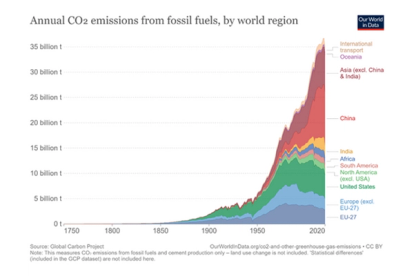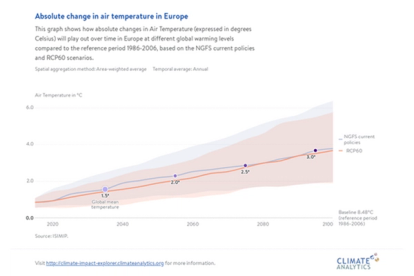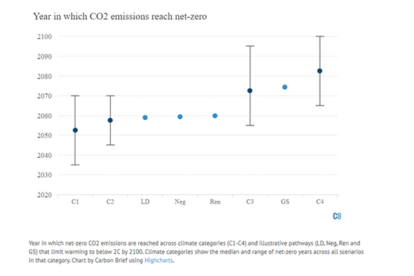
How to keep global warming to within 'safe levels' - review of the April 2022 IPCC report
- Post Date
- 14 February 2023
- Read Time
- 4 minutes

This blog post is the third in a four-part series unpacking the key pieces of information from the IPCC AR6 reports. Part one - The latest climate science from the IPCC. Part two - Key highlights from the IPCC Impacts, Adaptation and Vulnerability report.
The Intergovernmental Panel on Climate Change (IPCC) produces a set of major reports every seven years summarising the latest climate science and its implications for human society. It is currently in its sixth assessment report cycle (AR6).
In April 2022, the IPCC released the third report in the series, AR6 Climate Change 2022: Mitigation of Climate Change. This report explained what is required to limit global warming to below 1.5°C-2°C.
The good news (finally!), is that the report sets out a series of measures that companies, investors, governments and individuals should take to bring temperatures down to a safe level. This echoes the 2021 Net Zero by 2050 roadmap published by the International Energy Agency (IEA).
The headline statement from the report is that global greenhouse gas emissions must peak by 2025 to give the world a chance of limiting future heating to 1.5°C above pre-industrial levels. Global emissions have yet to peak, as shown by the data from 2020 in the chart below.

Annual CO2 emissions from fossil fuels, by world region
In simple terms, it is still technically feasible to bring temperatures down to 1.5°C-2°C. However, monumental action will be required, which is currently not happening.
For example, the IEA report states that for this scenario to be viable, “beyond projects already committed as of 2021, there are no new oil and gas fields approved for development in our pathway, and no new coal mines or mine extensions are required.” Whereas, in reality, there are many new fossil fuel projects being built around the world.
Key highlights from the report on scenarios and trajectories:
- The “trend from implemented policies until the end of 2020″ is consistent with a central estimate of warming – excluding climate system uncertainties – between 2.2°C and 3.5C in 2100.
- “Mitigation pathways limiting warming to 1.5°C with no or limited overshoot reach 50% reductions of CO2 in the 2030s, relative to 2019, then reduce emissions further to reach net-zero CO2 emissions in the 2050s.”
- In both cases, other GHG emissions will have to be reduced significantly, but are difficult to fully get down to zero given the diffuse sources of methane and nitrous oxide emissions.
- In 2°C pathways, emissions fall 50% “in the 2040s” and reach net-zero CO2 “by 2070s”.
- The report makes it clear that a failure to peak and reduce emissions in the coming decade will put Paris Agreement goals increasingly “out of reach”.
- The highest-end emissions scenarios, RCP8.5 and SSP5-8.5, “do not represent a typical ‘business-as-usual projection but are only useful as high-end, high-risk scenarios”, and that “the rapid development of renewable energy technologies and emerging climate policy have made it considerably less likely that emissions could end up as high as RCP8.5”.
- At the same time, the report suggests that these high-end scenarios can be useful to explore cases where existing climate policies are rolled back, or strong carbon cycle feedbacks result in extreme warming under a more plausible emissions scenario.
Important takeaways for TCFD-aligned climate scenario analysis and climate change risk assessments
The Network for Greening the Financial System (NGFS) “Current Policies” scenario, which falls under the “Hot House World” category, closely tracks RCP6.0, and is representative of the current policy trajectory. The chart below shows a comparison.

Absolute change in air temperature in Europe
However, the latest IPCC report confirms that the use of RCP8.5 for adaptation planning as a high-end warming scenario is logical, particularly because of the potential for climatic feedback loops to increase global temperatures.
Measures required to limit global warming
- While most scenarios that limit warming to well-below 2°C employ significant amounts of net-negative emissions, not all do.
- Scenarios with more immediate emissions reductions tend to have no or low overshoot and limit the amount of late-century carbon dioxide removal (CDR) needed.

Year in which CO2 emissions reach net-zero
- The fact that some of these models have a later net-zero emissions date does not imply that emissions reductions can be delayed, or that we “have more time to rapidly reduce current emissions levels compared to SR1.5”. Rather, the scenarios with the latest peak year are often the ones with largest near-term emissions reductions, as they reserve more of the remaining carbon budget for later years.
- When net-zero CO2 emissions are reached, scenarios generally have residual non-CO2 emissions ranging between 4-11GtCO2e.
- While technical measures can significantly reduce methane and N2O emissions at relatively low costs to about 50% of the current levels, the report says, further reduction may need to come from broader behavioural changes, such as switching to a less meat-intensive diet.
For support with climate change risk assessments, climate scenario analysis, developing your organisation’s climate strategy and capacity or responding to the TCFD reporting requirements please contact us.
Recent posts
-

-

Understanding sound flanking: Fire alarm speaker cable conduits in multi-family buildings
by Neil Vyas
View post -
